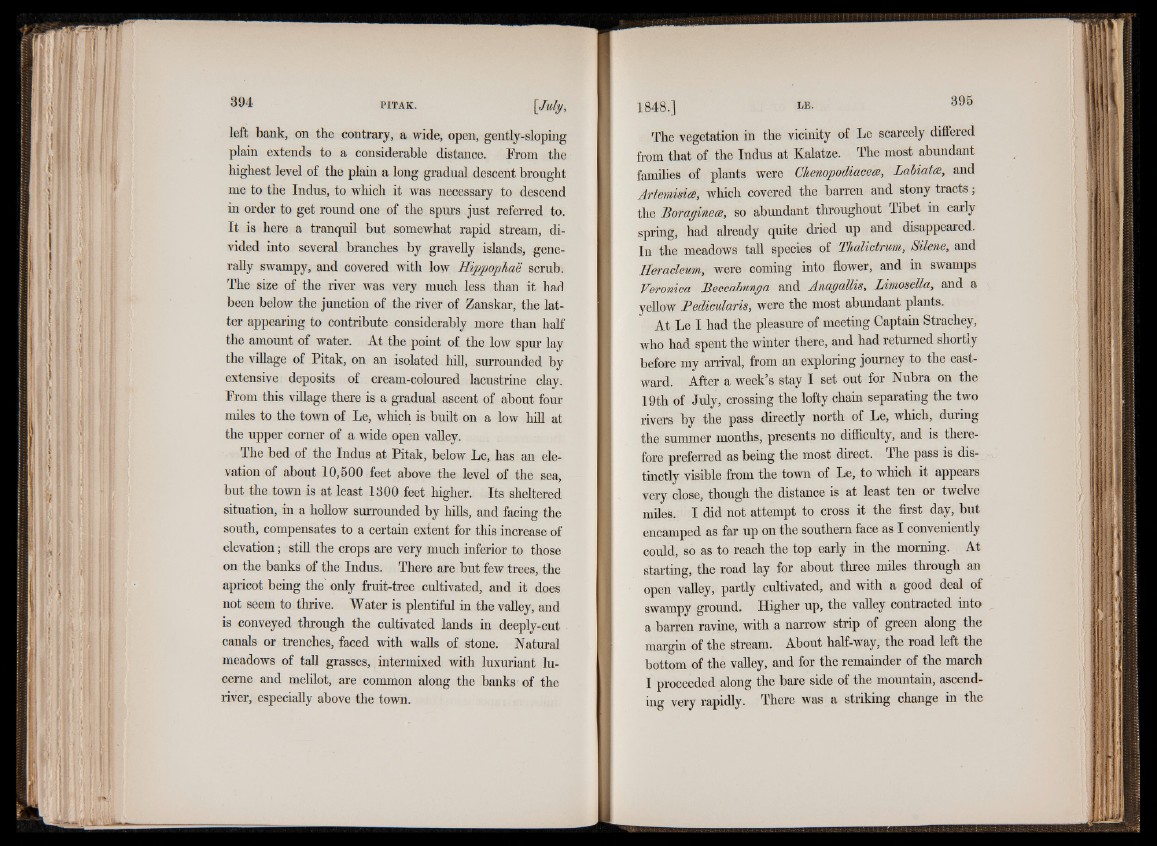
left bank, on the contrary, a wide, open, gently-sloping
plain extends to a considerable distance. From the
highest level of the plain a long gradual descent brought
me to the Indus, to which it was necessary to descend
in order to get round one of the spurs just referred to.
It is here a tranquil but somewhat rapid stream, divided
into several branches by gravelly islands, generally
swampy, and covered with low Hippcrphae scrub.
The size of the river was very much less than it had
been below the junction of the river of Zanskar, the latter
appearing to contribute considerably more than half
the amount of water. At the point of the low spur lay
the village of Pitak, on an isolated hill, surrounded by
extensive deposits of cream-coloured lacustrine clay.
From this village there is a gradual ascent of about four
miles to the town of Le, which is built on a low hill at
the upper comer of a wide open valley.
The bed of the Indus at Pitak, below Le, has an elevation
of about 10,500 feet above the level of the sea,
but the town is at least 1300 feet higher. Its sheltered
situation, in a hollow surrounded by hills, and facing the
south, compensates to a certain extent for this increase of
elevation; still the crops are very much inferior to those
on the banks of the Indus. There are but few trees, the
apricot being the only fruit-tree cultivated, and it does
not seem to thrive. Water is plentiful in the valley, and
is conveyed through the cultivated lands in deeply-cut
canals or trenches, faced with walls of stone. Natural
meadows of tall grasses, intermixed with luxuriant lucerne
and melilot, are common along the banks of the
river, especially above the town.
The vegetation in the vicinity of Le scarcely differed
from that of the Indus at Kalatze. The most abundant
families of plants were Chenopodiacea, labiates, and
Artemisia, which covered the barren and stony tracts;
the Boraginees, so abundant throughout Tibet in early
spring, had already quite dried up and disappeared.
In the meadows tall species of Thcdictrum, Silene, and
Heracleum, were coming into flower, and in swamps
Veronica Beccabunga and Anagallis, Limosella, and a
yellow Pedicularis, were the most abundant plants.
At Le I had the pleasure of meeting Captain Strachey,
who had spent the winter there, and had returned shortly
before my arrival, from an exploring journey to the eastward.
After a week’s stay I set out for Nubra on the
19th of July, crossing the lofty chain separating the two
rivers by the pass directly north of Le, which, during
the summer months, presents no difficulty, and is therefore
preferred as being the most direct. The pass is distinctly
visible from the town of Le, to which it appears
very close, though the distance is at least ten or twelve
miles. I did not attempt to cross it the first day, but
encamped as far up on the southern face as I conveniently
could, so as to reach the top early in the morning. At
starting, the road lay for about three miles through an
open valley, partly cultivated, and with a good deal of
swampy ground. Higher up, the valley contracted into
a barren ravine, with a narrow strip of green along the
margin of the stream. About half-way, the road left the
bottom of the valley, and for the remainder of the march
I proceeded along the bare side of the mountain, ascending
very rapidly. There was a striking change in the